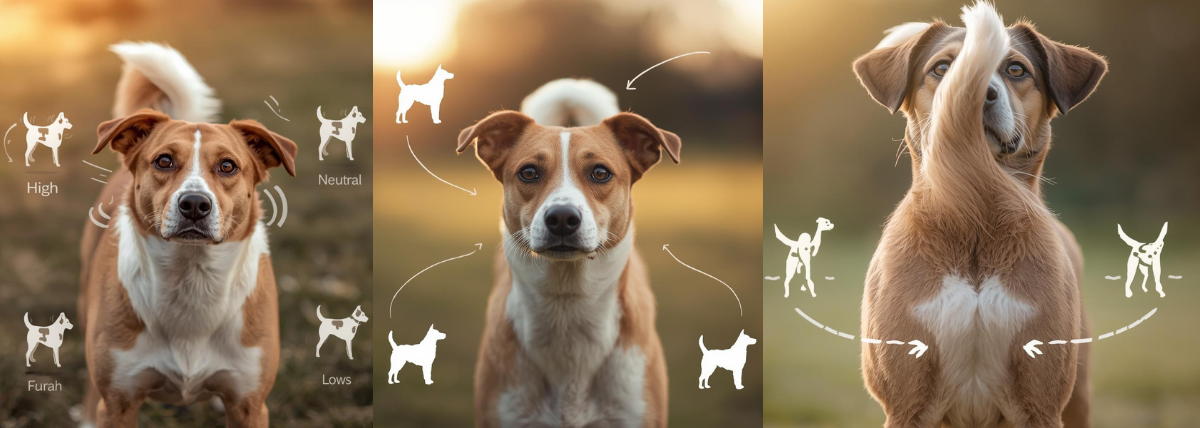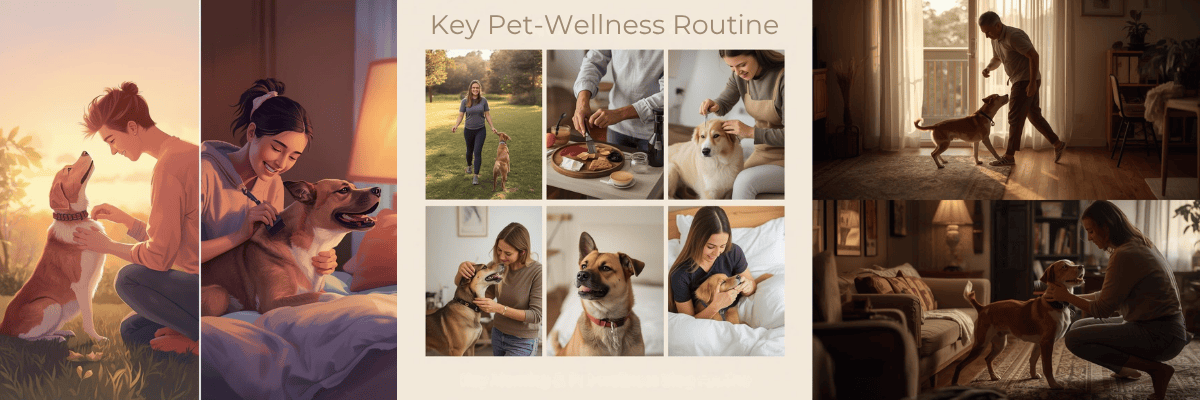Introduction
If you’ve ever been greeted by your dog’s wagging tail, you probably assumed it meant they were happy to see you. While that’s sometimes true, a wagging tail doesn’t always signal joy. In fact, dogs use their tails as a powerful communication tool, expressing everything from excitement and friendliness to fear, uncertainty, or even aggression.

Understanding what your dog’s tail wag really means can help you avoid misinterpretations, strengthen your bond, and respond to their emotional needs more effectively. In this post, we’ll explore the science behind tail wagging, the subtle differences in direction, speed, and position, and how context plays a key role in decoding your dog’s body language.
The Basics of Tail Communication
A dog’s tail is more than just a fluffy appendage—it’s a vital part of their communication system. Dogs rely heavily on body language to express emotions, and the tail is one of the most noticeable signals they use.

From an evolutionary perspective, tails served as a way for canines to signal intentions to pack members and other animals. A wag could indicate friendliness, readiness to play, or a warning to stay away. Over time, domesticated dogs have retained and refined this behavior, using tail movements to communicate not only with other dogs but also with humans.
Unlike vocal cues, which can sometimes be misleading, tail language tends to be instinctive and honest, reflecting a dog’s true emotional state. That’s why learning to read tail wags is one of the best ways to understand what your dog is really feeling.
Tail Wag Directions and Their Meanings
Not all tail wags are created equal—scientists have discovered that the direction of the wag can reveal a lot about a dog’s emotions.

Right-Side Wagging
- Research shows that when dogs wag more to the right side, it’s often linked with positive emotions.
- This is associated with relaxation, happiness, and seeing someone they trust.
Left-Side Wagging
- Wags that lean more to the left side are often tied to stress, caution, or alertness.
- Dogs may show this type of wag when confronted with an unfamiliar person, animal, or stressful situation.
Why Direction Matters
- These differences are connected to how the brain processes emotions.
- The left and right hemispheres of a dog’s brain control opposite sides of the body, influencing which way the tail moves depending on the emotional state.
So the next time you notice your dog wagging, pay attention—not just to the fact that it’s wagging, but to which way it leans.
Tail Wag Speed and Intensity
It’s not only the direction of a wag that matters—how fast and intense the wagging is can also reveal your dog’s emotional state.

Fast Wagging
- Rapid tail movement often signals excitement or high energy.
- This could mean happiness, like when you come home from work, but it can also indicate overstimulation, so context is important.
Slow Wagging
- A slower wag may show uncertainty, caution, or hesitation.
- Dogs sometimes wag slowly when they’re unsure about a situation, like meeting a new person or animal.
Broad Sweeps vs. Short, Stiff Wags
- Broad, sweeping wags usually mean friendliness and openness.
- Short, stiff wags can be a warning, often paired with a tense body and upright posture, signaling possible aggression or defensiveness.
By observing the speed and intensity of the wag, you can better interpret whether your dog is excited, nervous, or sending a warning.
Tail Position as a Signal
A dog’s tail position is just as important as the wag itself. Where the tail is held gives valuable clues about how your dog feels in the moment.

High-Held Tail
- A tail held high and stiff often signals confidence, alertness, or even dominance.
- If paired with rigid body language, it may also indicate a warning to back off.
Neutral or Relaxed Tail
- A tail in its natural, mid-level position usually shows that a dog is calm and comfortable.
- Gentle wagging at this level often reflects contentment.
Low or Tucked Tail
- A tail held low or tucked between the legs typically signals fear, submission, or insecurity.
- Dogs may show this when they feel threatened, nervous, or overwhelmed.
By paying attention to tail height along with the wag, you can better understand whether your dog is relaxed, confident, or feeling vulnerable.
Context Matters
While tail wagging reveals a lot, it should never be read in isolation. Dogs use their entire body to communicate, and the meaning of a wag often depends on the bigger picture.

Body Language Clues
- A wag paired with a relaxed body, soft eyes, and loose posture usually signals friendliness.
- A wag with a stiff body, raised hackles, or intense staring may indicate agitation or aggression.
Situational Context
- A dog wagging around family members likely shows affection.
- The same wag when meeting a stranger might signal nervous excitement or uncertainty.
Breed Differences
- Some breeds naturally carry their tails higher or curl them over their backs (e.g., Huskies, Pugs).
- Dogs with docked tails may communicate less clearly, requiring owners to rely more on other signals.
In short, always look at the whole dog—ears, eyes, posture, and setting—before deciding what a wag means.
Quick Tail Language Chart
| Tail Position | Speed | Direction | Emotion |
| Mid-level, broad wag | Fast | Right | Happiness |
| High, stiff | Slow | Neutral | Alert/dominant |
| Low, tucked | Slow | Left | Fear/submission |
| Short, tight wag | Rapid | Left | Tension or warning |

Misinterpretations Owners Make
Many dog owners assume that all tail wagging is a sign of happiness—but that’s one of the biggest misconceptions about canine body language.

“Wagging Means Friendliness”
- Not every wag means a dog wants to be approached.
- Some wags signal stress, fear, or even a warning to stay back.
Overlooking Subtle Warnings
- A stiff, short wag combined with tense body language often means a dog is uncomfortable.
- Ignoring these signals can lead to unwanted confrontations or bites.
Breed Variations
- Dogs with curled tails (like Akitas or Shibas) or docked tails may express themselves differently.
- Owners should learn their specific dog’s tail “language” rather than relying on general assumptions.
By avoiding these common mistakes, you’ll be better equipped to respect your dog’s boundaries and respond appropriately to their needs.
How to Respond to Different Wags
Understanding your dog’s tail signals is only half the equation—the other half is knowing how to respond.

Positive, Relaxed Wags
- If your dog’s wag is loose and friendly, respond with affection, play, or praise.
- This reinforces their happiness and strengthens your bond.
Cautious or Uncertain Wags
- When the wag is slow or hesitant, give your dog space and reassurance.
- Avoid forcing interaction; instead, let them approach at their own pace.
Stiff or Defensive Wags
- If the wag looks tense or short, paired with rigid posture, do not push closer.
- Stay calm, remove stressors if possible, and give your dog room to feel safe.
By matching your response to your dog’s tail signals, you’ll not only improve communication but also build trust and confidence in your relationship.
Conclusion
A wagging tail is more than just a sign of joy—it’s a window into your dog’s emotions. From relaxed sweeps of happiness to stiff, guarded movements of stress, each wag carries meaning. By paying attention to direction, speed, and body language context, you can better understand what your dog is trying to tell you.

The next time you see that tail in motion, don’t just assume—it’s an opportunity to listen, connect, and respond in a way that makes your bond even stronger. After all, when you learn to read the wag, you’re speaking your dog’s language.




Leave a Reply